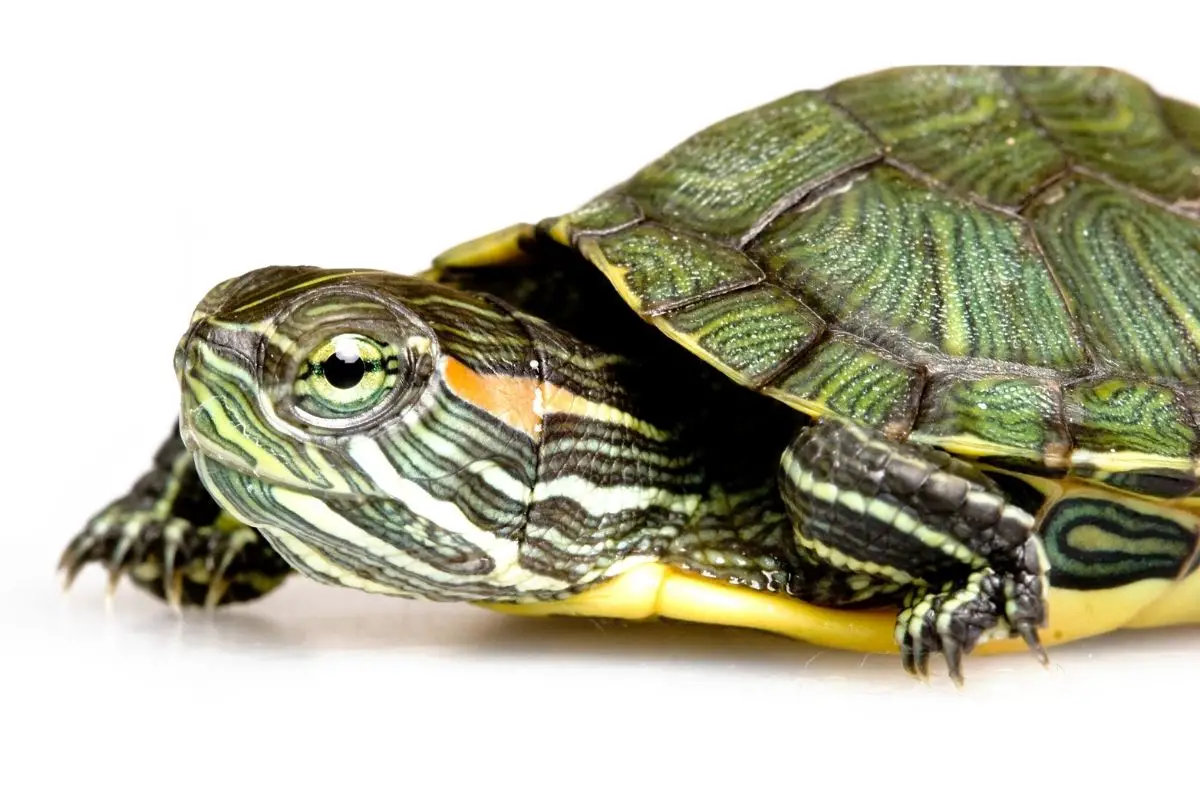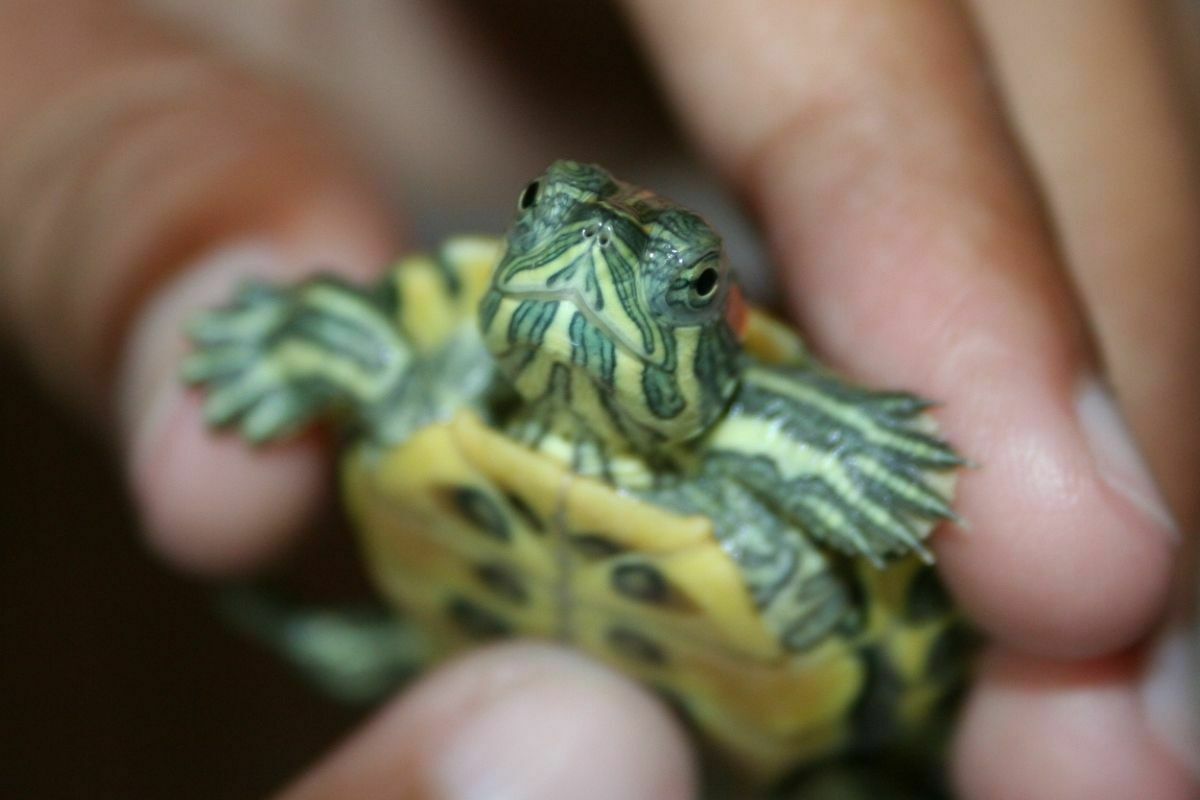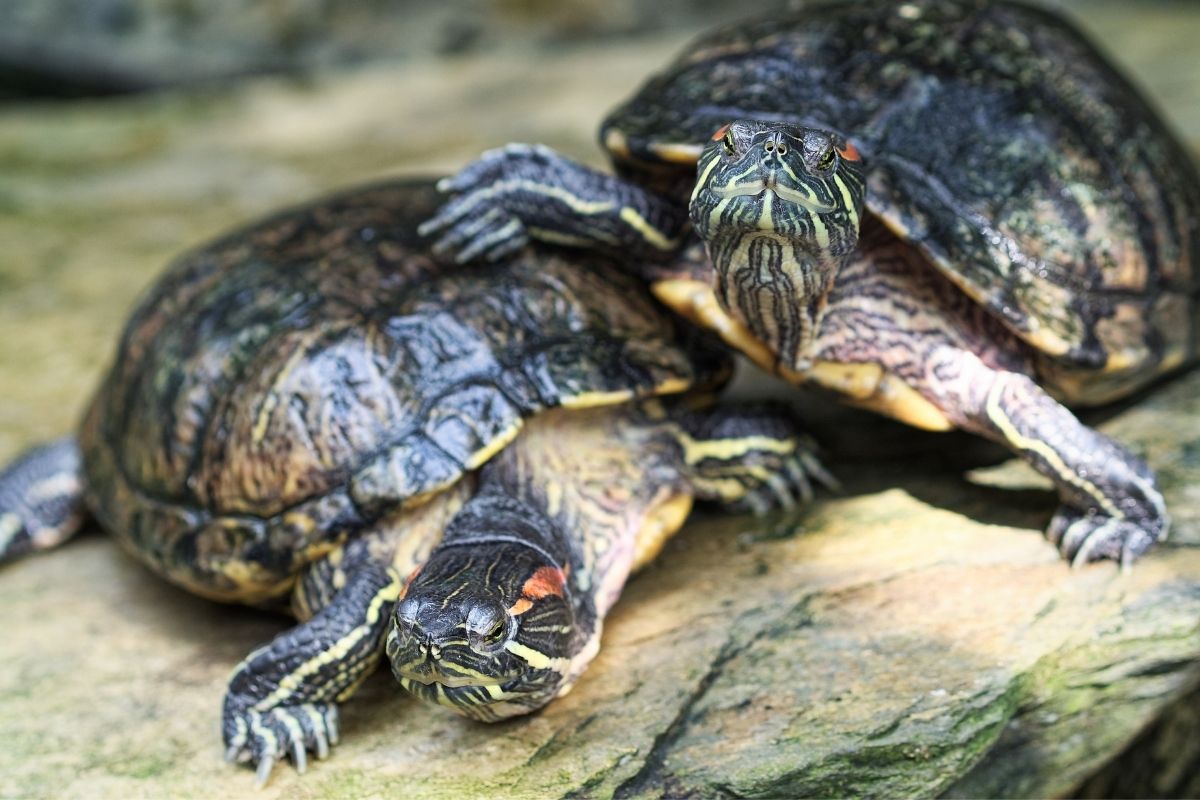Red-eared sliders are easily one of the most recognizable breeds of turtle from across the world, and this has led to them being very popular as pets.
This comes despite the fact that the species is known for being an invasive species in some countries across the world and for potentially spreading salmonella.

Despite all of this, red-eared sliders are still highly beloved turtles and even valued pets, potentially because of their adorable appearances and small stature.
But many people that own red-eared sliders, or those just interested in them, very often wonder just how big the creatures can get.
You’re very likely here right now because you want to know exactly how big red-eared sliders can get as they mature and what can cause them to grow larger.
There are many things involved in affecting the size of a red-eared slider, so why don’t dive right in and get started on finding out how big they can get?
Read on below to get the answers you’ve been searching for!
How Big Can A Red-Eared Slider Get?
On average, most red-eared slider turtles reach around 12 inches at the largest, but this depends on a number of mitigating factors to allow them to grow to such a size.
Red-eared sliders can grow quite significantly over time, but the rate and the extent of this growth are affected by quite a large number of factors.
Why don’t we take a good look at some of these factors?
Age
One of the biggest factors that can dictate the continued growth of a red-eared slider is that of age. During the first five years of their lives, red-eared sliders grow fairly significantly and very rapidly.
This rate slows down slightly until they reach the age of seven, by which time most red-eared sliders have reached their maximum size.
Thus, red-eared sliders do most of their growing in the very earliest years of their life, because the average lifespan of a red-eared slider is around 30 years, provided that they have been adequately cared for.
Diet
Of course, a good diet is vital in helping a red-eared slider to reach its maximum size. Turtles have a very varied diet, and the quality of what they eat can have an effect on how they grow.
When red-eared sliders are in the wild they feed on omnivorous diets, and they are very capable of finding their own food.
They enjoy eating vegetation and smaller animals like frogs and newts, and these are in plentiful supply in the wild.
Unfortunately, many red-eared slider owners have trouble helping their turtles to reach their full growth potential, as they have trouble accurately balancing the omnivorous diets of the turtles.
Generally, when in the wild, red-eared sliders’ diets consist mostly of vegetation, while they occasionally hunt down smaller creatures in order to get the protein that they need in their diet and in order to promote healthy growth.
This is why many owners of the creatures have a lot of trouble consistently feeding them.
If you own a red-eared slider and you want to help it to reach its optimal size, make sure to feed it a diet that consists mostly of vegetables, with the occasional treat of live fish, insects, or smaller creatures.
Try placing vegetables that can float into the turtle enclosure. This will ensure that the turtles have plenty that they can snack on during the day, and the ability to eat the vegetables while swimming in the water helps them to act as they would in the wild, which can be beneficial for their health and continued growth.
In terms of live creatures such as fish and insects, though they may initially be difficult to get your hands on, they are incredibly beneficial for turtles.
Insects such as worms and crickets are great to feed to red-eared sliders, as they make for wonderful sources of protein, which helps to keep the turtles fuller for longer and helps to promote their growth. They also contain very little fat.
In terms of fish, they are best placed in the turtle enclosure while still living so that they can swim about. This will cause the prey instinct of the turtles to be stimulated so that they can stay healthy both mentally and physically.
Fish are also full of calcium, which helps to lead to stronger bones and much healthier shells, which makes them crucial for red-eared slider turtles.
When red-eared sliders are still in their early years, when they are doing much of their growth, it is important to supply them with plenty of food in the form of fish and insects, as that is the time in which the protein and calcium from such creatures are highly beneficial.
As the turtles mature, they begin to eat more and more plants, and they start to become less interested in live foods.
The reason for this is that they are now able to find enough food through hunting and scavenging, and they have already done most of their growing.
Enclosure Space
If you have a red-eared slider that you want to help grow to be strong, healthy, and full-sized, then you will need to ensure that you give it the requisite enclosure space.
It may come as some surprise to hear, but if a turtle has only a very small enclosure to roam around in, then it will not be able to grow as effectively, and it will likely fail to reach its full potential size.
The most crucial thing to consider when deciding where to keep your red-eared slider is to place it in an enclosure that allows it to roam around with plenty of room and get its requisite exercise.
This allows the turtle to keep fit, and also allows it to strengthen its body throughout, which helps to further promote healthy growth so that you can ensure that your turtle reaches its optimal size.
You should aim for your enclosure to be more than four or five times the size of the red-eared slider’s shell. This allows them plenty of space to roam around, which is perfect for allowing them to exercise.
You should also ensure that your enclosure has plenty of bodies of water of an adequate depth so that the turtle can swim.
Red-eared slider turtles are incredibly active and simply adore swimming, so giving them plenty of space to do exactly that is crucial.
Of course, if you have multiple red-eared sliders, you will also want to ensure that you find a much larger enclosure that has enough space for all of them.
If you are planning to own more than one red-eared slider at one time, make sure to consider just how much time and space you have.
Keep in mind that the water in your turtle enclosure will need to be properly cleaned and maintained, as water that has become unclean can develop harmful bacteria that can be damaging to the health of your turtles as well as your own health.
The more water there is in your turtles’ enclosure, the longer and more difficult the cleaning job will be!
Gender
The gender of your red-eared slider will also have a significant impact on the full size that it will reach. Though it is not always the case, female red-eared sliders most often grow to be slightly larger than their male counterparts.
Thus, if any of your turtles are female, you should expect them to be slightly larger than any male counterparts.
The reason that female red-eared sliders are so different in terms of size is thanks to sexual dimorphism, which kicks into action around the age of 5 when the rapid growth of the turtle finally begins to slow down slightly.
What Size Is A Red-Eared Slider When It Is First Born?

Red-eared sliders begin life at a very tiny size, which makes them very adorable in appearance. In the first few months of their life, the average red-eared slider is around 1 inch in length.
They begin to slowly grow over the next five years of their life, growing upwards of two inches every year until they reach the age of five. This is a very rapid rate of growth, which makes it very interesting to behold.
When a young red-eared slider reaches the age of five, this rapid rate of growth naturally begins to slow down, and you will find that, by the age of seven, the turtle has reached its optimal size and will have finished growing.
How Heavy Can A Red-Eared Slider Get?
By the time a red-eared slider has reached its full size, they can become incredibly heavy, thanks to their strong and sturdy shells and the generally stocky shape of their overall build.
Females of the species can reach upwards of 550 grams once fully grown. On the other hand, male red-eared sliders tend to reach a maximum weight of anywhere between 250 to 300 grams.
This is thanks to the processes of sexual dimorphism.
How Big Was The Largest Ever Red-Eared Slider?
Unfortunately, there are no records of any red-eared sliders ever having grown to be larger than twelve inches. This goes to show just how big they can become.
Do Red-Eared Sliders Make For Good Pets?
Red-eared sliders can make wonderful pets, and they can be very rewarding to care for.
They can live for many years with property and adequate care, and this means that they can be lifelong companions, which makes them very worth caring for.
However, it needs to be noted that caring for red-eared sliders requires a massive amount of care and that a massive amount of time be dedicated to them in order to ensure that they grow up to be strong and healthy.
The turtles require large habitats in order to grow to their fullest potential, and maintaining such large enclosures is where much of your time will be spent.
You will need to ensure that the entire enclosure is properly maintained to be safe for the turtle and to provide them with plenty of room to move about.
You will also need to ensure that the water within the enclosure is clean so that no nasty and harmful bacteria can be allowed to develop.
Buying a large enclosure for a red-eared slider is also very costly, and this is where much of your money will be spent.
Once you have the enclosure, you also must consider the maintenance costs of said enclosure, which can be quite significant, especially considering just how long such turtles can live for.
You should also consider the costs of food and veterinary care for your turtle, as both are essential for maintaining their health adequately and allowing them to grow to their full size.
How Often Should You Feed A Baby Red-Eared Slider?
You should make sure to feed a baby red-eared slider every single day. This is because the early years of a red-eared slider’s life are a very crucial time in which much of the growing is done.
You should aim to feed them a portion of food that is around the average size of their head. This is around a tablespoon’s worth of food.
You should make sure to feed the baby turtle a balanced diet of vegetables and meats so that it can get everything it requires for healthy growth.
Insects and fish are perfect at this time in their life, as they contain plenty of calcium and protein, which is perfect for helping baby turtles to grow so that they can reach their fullest size.
How Do You Care For A Red-Eared Slider Turtle?

Luckily, red-eared slider turtles are fairly independent and are able to maintain their habitats very effectively.
However, they do still require some work to keep maintained, and thus you need to make sure that you care for them in the proper way.
Red-eared sliders are not overly sociable creatures, and thus they can be quite aggressive if not handled or cared for adequately.
Provided you feed your turtle regularly enough and you keep their enclosure clean and beautiful, then you are already doing a fantastic job.
However, you should also make sure to keep a close eye on the health of your turtle, which can be quite difficult to do if you don’t know what to look out for.
Check your turtle’s main features regularly, as these are generally where problems will make themselves evident.
Check your turtle’s eyes, as eye infections are very common and can develop very quickly. If the eyes are infected, they will appear swollen and puffed up.
If you suspect that your turtle has an eye infection, make sure to contact your vet so that they can determine the situation.
You should also check that your turtle’s enclosure has adequate water filtering. Much of the bacteria that can lead to eye infections come about from ill-filtered water.
You should also check to see whether your turtle ever acts differently from how you usually expect it to. Has your turtle lost its appetite? Or is it completely refusing to eat altogether?
If so, you should make a point of carefully checking its mouth. Be wary that turtles do not generally appreciate having their heads touched, so you should approach the situation with care.
You want to check to see if there are any strange furry patches on the turtle’s mouth at any point.
If there are, then your turtle likely has a bacterial infection, and you should visit your vet as soon as you can so that your turtle can begin a course of antibiotic treatment.
Is your turtle also acting slightly more lethargic or wheezing as it moves around? This could be a sign of a respiratory infection, and thus you should aim to visit your vet as soon as possible, as this can cause severe long-term damage to the turtle.
Finally, you will also want to check the turtle’s shell. The turtle’s shell should feel sturdy and strong, but if it ever feels softer or lighter than usual, you should aim to take it to your vet immediately.
The reason for a softer shell may be a lower exposure to direct light, such as from an overhead lamp or sunlight.
If you want to help your turtle to soak in a little bit of sunlight, then you should fill up a small pool with water in your yard and then place a small platform for the turtle to float on top of the surface of the water.
Place the pool in direct sunlight, and the turtle will slowly absorb some of the nutrients from the light.
Finally, when taking care of a turtle, you should also make sure to spend some time with it.
As we have mentioned previously, red-eared sliders are not the most sociable animals, and thus you need to be careful when handling them, as they are known to bite when they feel threatened.
You can pet your turtle, and this can be done directly on the shell. Many do not know that the shell of the turtle has plenty of nerve endings and thus is very sensitive.
As a result, you should make sure to pet your turtle softly so that you do not cause it any harm. This will help your turtle to bond better with you.
Frequently Asked Questions
Do Red-Eared Sliders Like To Live Alone?
Red-eared sliders are fairly antisocial creatures and very much enjoy their own company and plenty of time to be isolated. Thus, if you own one, you should make sure to allow it plenty of space.
Thus, generally, you should avoid keeping red-eared sliders in enclosures alongside other species of turtle, as they have been known to be very aggressive to other creatures that share their enclosures.
Do Red-Eared Sliders Bite?
Yes. Red-eared sliders are known to be very independent creatures, and thus if you disturb them when they want to be alone, they will very likely bite.
Turtles in general, are known to bite, especially when you touch them around their heads, which are very sensitive areas.
If you want to avoid being bitten, then you should make sure to only ever handle red-eared sliders with the utmost care so as to avoid touching any sensitive or painful spots on the turtle’s body.
Do Turtles Get Bored In A Tank?
Yes. Turtles can very easily and very quickly become bored in a tank, and this is why you should make sure to allow yours some time outside of the tank while supervised.
Try taking your turtle out into your yard when it is sunny, and allow it to explore a small range of grass or paddle around in a small pool. This will help to strengthen its shell, as the nutrients from the sunlight are highly beneficial.
To Conclude
As you have now seen, red-eared slider turtles can grow to become quite significantly large! Around 12 inches is the general average, and some of the biggest red-eared slider turtles in existence have been recorded at this size.
However, in order to reach that size, red-eared slider turtles need adequate enclosures so that they are not cramped in, and so that they have plenty of room to move about and exercise.
They also need a very balanced diet of meat and vegetables, which have all of the vital nutrients necessary to allow that growth to occur optimally.
This is part of the reason why red-eared slider turtles can make for such rewarding pets, as watching them grow, which is a very rapid process, can be immense to witness firsthand.
However, this also means that taking care of them requires not only a lot of money to keep their enclosures maintained and keep them fed, but also a lot of time and effort to ensure that the turtle has everything it needs to be able to grow.
